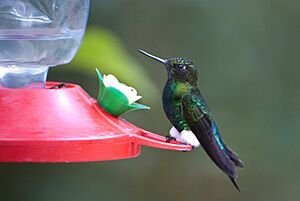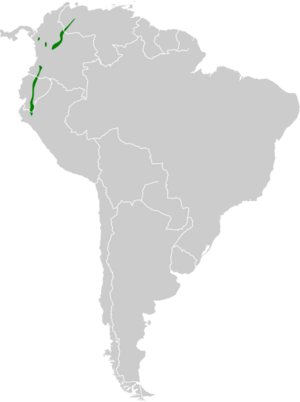Glowing puffleg facts for kids
Quick facts for kids Glowing puffleg |
|
|---|---|
 |
|
| Conservation status | |
| Scientific classification | |
 |
The glowing puffleg (Eriocnemis vestita) is a type of hummingbird known for its bright colors. It's part of a group of hummingbirds called "brilliants." You can find this beautiful bird in several South American countries, including Colombia, Ecuador, Peru, and Venezuela.
Contents
Meet the Glowing Puffleg
The glowing puffleg is a small bird, usually about 9 to 10 centimeters (about 3.5 to 4 inches) long. Males weigh between 3.3 and 7.2 grams, which is less than a quarter of an ounce! Females are slightly lighter, weighing 3.6 to 5.3 grams.
What Does a Glowing Puffleg Look Like?
This hummingbird has a straight, dark bill. The male glowing puffleg has shining dark green feathers on its back. Its lower back and the feathers covering its tail are a golden green color.
It has a sparkling purple patch on its throat, outlined with golden green. The rest of its throat and upper chest are a shiny blackish green. Its belly is a glittering golden green, and the feathers under its tail are a shimmering purplish blue. One of its most special features is the fluffy white feathers around its legs, which look like little "puffs." Its tail is dark steel blue and shaped like a fork.
Female glowing pufflegs are also beautiful, with shining golden green upperparts. Their throat patch is different, with a few bluish-purple spots on a light, yellowish-brown background. The rest of their throat and chest are yellowish-brown, and their belly is grayish-white, all with golden green spots. Young glowing pufflegs look similar to the females.
Different Kinds of Glowing Pufflegs
There are four main types, or subspecies, of the glowing puffleg. They look a little different from each other and live in various parts of South America:
- E. v. paramillo: This type lives in the northern parts of Colombia's Western and Central Andes mountains.
- E. v. vestita: You can find this one from northwestern Venezuela into the Eastern and Central Colombian Andes.
- E. v. smaragdinipectus: This type lives in the southern Central Andes of Colombia, stretching south into Ecuador.
- E. v. arcosae: This subspecies is found in the Andes of southern Ecuador and the very northern parts of Peru.
Where Glowing Pufflegs Live
Glowing pufflegs live in many different kinds of open areas. They especially like the edges of cloudforests and elfin forests, which are forests often covered in mist. They also live on brushy hillsides, in old pastures that have grown wild, and in high-altitude grasslands called páramo. Sometimes, they can be found in thicker subtropical forests.
These birds live at high elevations, usually between 2,300 and 4,200 meters (about 7,500 to 13,800 feet) above sea level. Most often, you'll find them between 2,800 and 3,500 meters (about 9,200 to 11,500 feet).
Glowing Puffleg Behavior
Movement
The glowing puffleg tends to stay in one area and does not migrate.
What Glowing Pufflegs Eat
These hummingbirds mainly drink nectar from flowers. They prefer flowers on low-growing shrubs that have short, tube-shaped petals. They can get nectar by hovering in front of a flower, perching on it, or sometimes even clinging to it. Glowing pufflegs are known to be quite "feisty" and will defend their favorite flowering plants from other birds. Besides nectar, they also eat insects and spiders, which they catch by flying out from a perch to snatch them in the air.
Reproduction and Life Cycle
Scientists don't know everything about when glowing pufflegs breed. In Colombia's Eastern Andes, it seems they might nest almost any month of the year, except for July. We don't have many details about their nests, except that they are often built in tall grass. The female bird takes care of incubating the two white eggs. The exact time it takes for the eggs to hatch or for the young birds to leave the nest is still a mystery.
Sounds and Calls
The only sound described for the glowing puffleg is a single, metallic note that sounds like "tseek" or sometimes a double "tsi-tseek." They repeat this sound at different times, whether they are sitting on a branch or hovering in the air.
Conservation Status
The IUCN (International Union for Conservation of Nature) has listed the glowing puffleg as a species of "Least Concern." This means that even though we don't know the exact number of these birds, their population is believed to be stable. They live in a large area and are found in some protected places. They also seem to do well in areas where forests have been cut down and new plants are growing, like old pastures.


